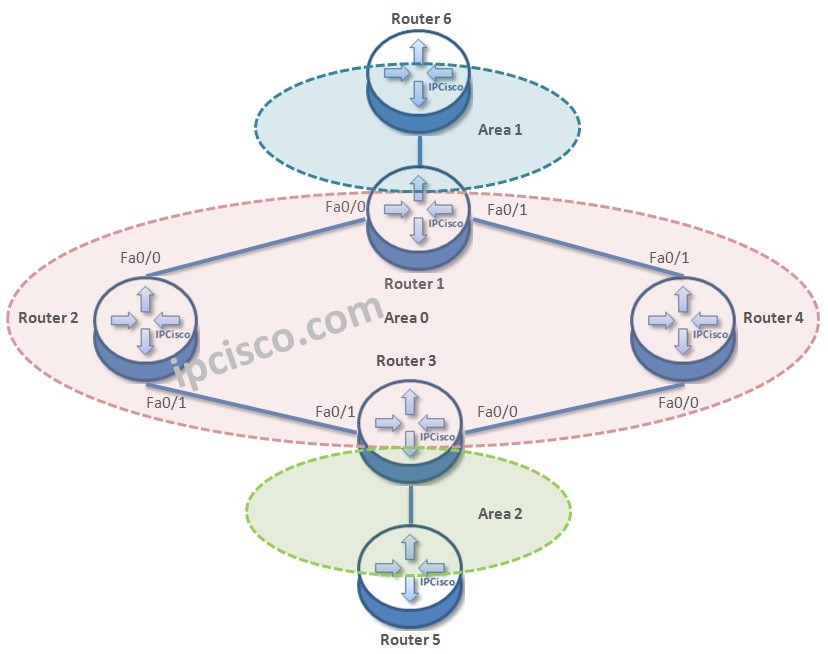- COURSES
- SPECIALS
- BLOG
- MEMBERS
- SHOP
- ABOUT
- ENROLL HERE

Table of Contents
OSPFv3 is the IPv6 cabaple version of OSPF. The previous version of OSPF was OSPFv2. OSPFv2 is for IPv4.
Here, we will configure OSPFv3 for the below topology. As you can see, there are three areas and six routers in this topology.
For OSPFv3 Configuration, we will follow the below steps one by one:
Now, let’s go to each Configuration steps one by one.
Firstly, we will enable global IPv6 Routing on each Router with “ipv6 unicast-routing” command.
Router 1 # config terminal
Router 1 (config) # ipv6 unicast-routing
Router 2 # config terminal
Router 2 (config) # ipv6 unicast-routing
Router 3 # config terminal
Router 3 (config) # ipv6 unicast-routing
Router 4 # config terminal
Router 4 (config) # ipv6 unicast-routing
Router 5 # config terminal
Router 5 (config) # ipv6 unicast-routing
Router 6 # config terminal
Router 6 (config) # ipv6 unicast-routing
Secondly, we will enable IPv6 under interfaces with “ipv6 enable” command.
Router 1 (config) # interface fa0/0
Router 1 (config-if) # ipv6 enable
Router 1 (config-if) # interface fa0/1
Router 1 (config-if) # ipv6 enable
Router 1 (config-if) # interface fa0/1
Router 1 (config-if) # ipv6 enable
Router 2 (config) # interface fa0/0
Router 2 (config-if) # ipv6 enable
Router 2 (config-if) # interface fa0/1
Router 2 (config-if) # ipv6 enable
Router 3 (config) # interface fa0/0
Router 3 (config-if) # ipv6 enable
Router 3 (config-if) # interface fa0/1
Router 3 (config-if) # ipv6 enable
Router 3 (config-if) # interface fa0/1
Router 3 (config-if) # ipv6 enable
Router 4 (config) # interface fa0/0
Router 4 (config-if) # ipv6 enable
Router 4 (config-if) # interface fa0/1
Router 4 (config-if) # ipv6 enable
Router 5 (config) # interface fa0/0
Router 5 (config-if) # ipv6 enable
Router 6 (config) # interface fa0/0
Router 6 (config-if) # ipv6 enable
In the third step, we will do the IPv6 address configuration. We will use “ipv6 address -ipv6address- eui-64“ commands. The Link-local addresses required for neighbourship, will produce Link-local addresses with this command.
Router 1 (config) # interface fa0/0
Router 1 (config-if) # ipv6 address 2001:1234:0:111::1/64 eui-64
Router 1 (config-if) # interface fa0/1
Router 1 (config-if) # ipv6 address 2001:1234:0:222::1/64 eui-64
Router 1 (config-if) # interface fa0/1
Router 1 (config-if) # ipv6 address 2001:1234:0:555::1/64 eui-64
Router 2 (config) # interface fa0/0
Router 2 (config-if) # ipv6 address 2001:1234:0:111::2/64 eui-64
Router 2 (config-if) # interface fa0/1
Router 2 (config-if) # ipv6 address 2001:1234:0:333::1/64 eui-64
Router 3 (config) # interface fa0/0
Router 3 (config-if) # ipv6 address 2001:1234:0:444::2/64 eui-64
Router 3 (config-if) # interface fa0/1
Router 3 (config-if) # ipv6 address 2001:1234:0:333::2/64 eui-64
Router 3 (config-if) # interface fa0/1
Router 3 (config-if) # ipv6 address 2001:1234:0:666::1/64 eui-64
Router 4 (config) # interface fa0/0
Router 4 (config-if) # ipv6 address 2001:1234:0:444::1/64 eui-64
Router 4 (config-if) # interface fa0/1
Router 4 (config-if) # ipv6 address 2001:1234:0:222::2/64 eui-64
Router 5 (config) # interface fa0/0
Router 5 (config-if) # ipv6 address 2001:1234:0:555::2/64 eui-64
Router 6 (config) # interface fa0/0
Router 6 (config-if) # ipv6 address 2001:1234:0:666::2/64 eui-64
Now, it is time to configure OSPFv3 process under each router. We will use the process number 1 here. Beside, we will configure a router ID in IPv4 format. Because for both OSPv2 and OSPv3, Router ID is in IPv4 format.
Leave a Reply